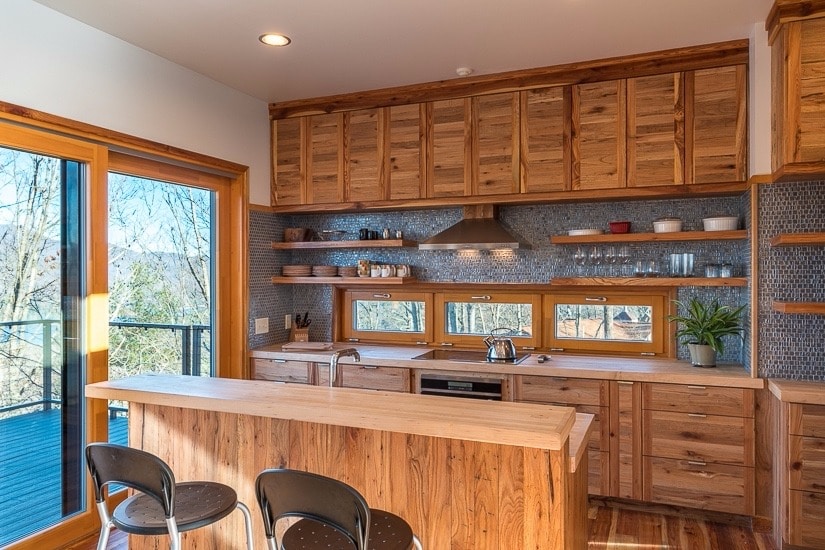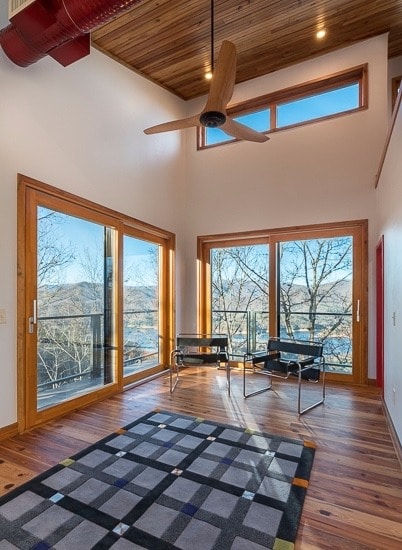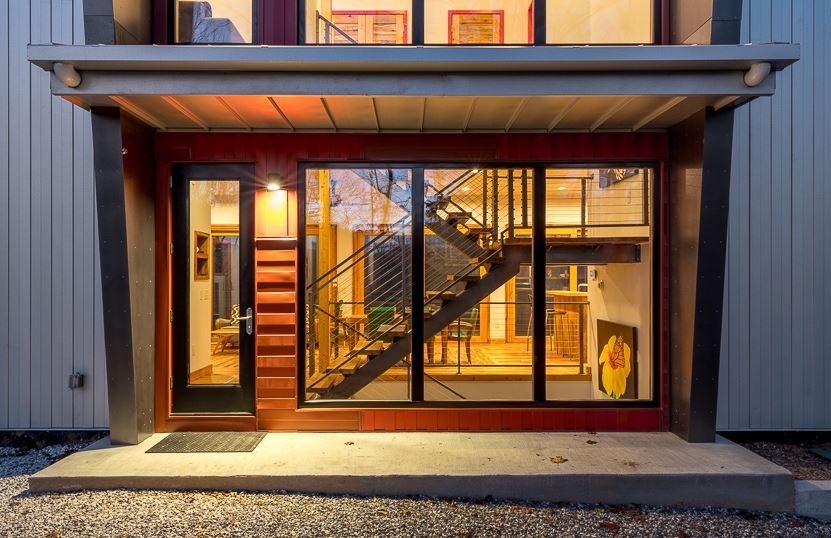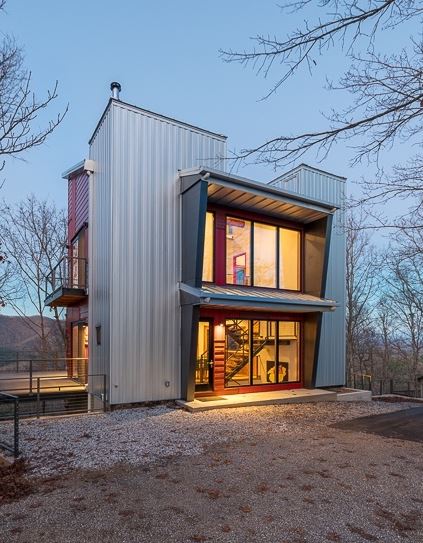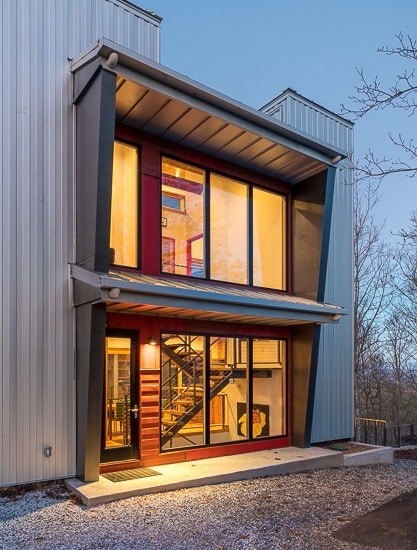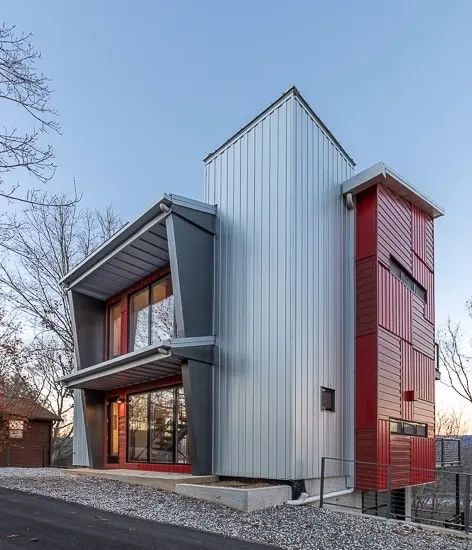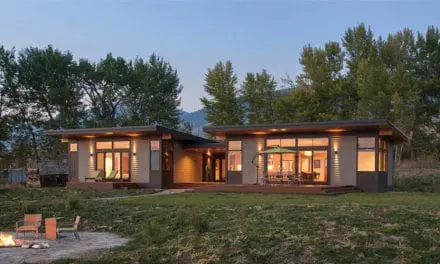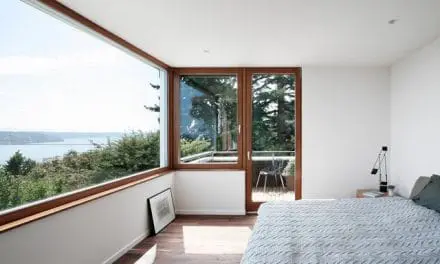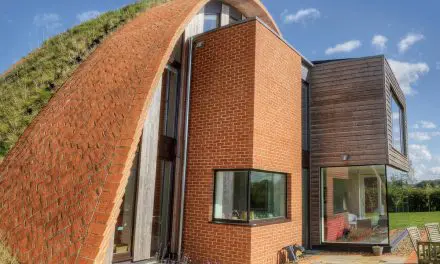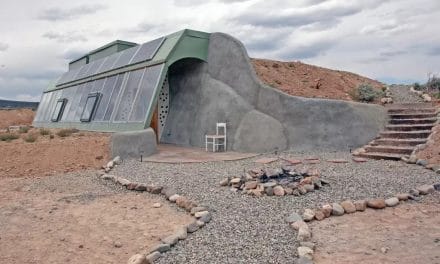Against the backdrop of North Carolina’s Lake Fontana, Blue Ridge and Great Smoky mountains, perched on a steep hillside, you will find the “Love Shack.” Located in Fontana Dam, North Carolina, the three-story modern home features two bedrooms, three bathrooms, a wraparound porch, a private balcony, as well as an open room that incorporates the kitchen, dining area, living area and attached garage. The “Love Shack,” is far from what anyone would consider a ‘shack.’ In fact, it is nearly impossible not to find something to fall in love with about this home, between the breathtaking Appalachian surroundings, the contemporary architectural design of the home with an industrial flair to the exterior, and the clean open floor layout of the interior, decorated with midcentury modern furnishings.
PROJECT NAME
The Love Shack
LOCATION
Fontana Dam, NC
SPECS
2 bed/3 bath, 1800 sq/ft
YEAR OF COMPLETION
2015
The home is a monument of its owners, Ken and Dr. Cindy LaRoe, whose love of the planet inspired an eco-friendly home design that creates as much energy as it uses, which is known as achieving ‘Net-Zero’ energy and water consumption. To meet this standard, the house incorporates thermal windows, water collection system, photovoltaic panels and other energy-efficient features. It also incorporates several design elements personal to the couple, such as the home’s heart pine cabinets, which were made from trees salvaged from their hometown in Florida, after being killed by pine borer beetles.
Ken and Cindy are passionate about clean energy, believing it is paramount to protect our air, water and land from pollution to save the future of our shared planet and humanity as we know it. The couple’s eco-friendly choices at the Love Shack also reflect Ken’s business approach, embodied through his company, First GREEN Bank. Ken founded the bank in 2009 with a mission to promote business that is financially, environmentally and socially responsible. Since then, the bank continues to prioritize eco-friendly practices by having all of its buildings built or “GREENovated” to meet the highest levels of sustainability. The company, which has loaned more than $500 million to the communities it serves, is known for its progressive initiatives, such as offering discounts on solar energy loans and providing customers with electric car charging stations.
Overall, the “Love Shack” is a special and meaningful place for Ken and Cindy, where visitors can decompress, appreciate nature and take part in a movement toward a sustainable future.

The home’s floors are two different species of tree, salvaged from a site that had been cleared for real estate development.
PROJECT GOALS
The project entailed a great deal of planning by the homeowners, Ken and Dr. Cindy LaRoe, and required collaboration with a range of design, construction and environmental specialists.
The main, functional goal was to design a sustainable, low maintenance structure that would disrupt as little of the surrounding environment as possible, in order to preserve the area’s natural elements and to reduce the couple’s carbon footprint. This goal was greatly surpassed, having created a Net-Zero residence, meaning it produces as much energy and water as it consumes, which is LEED Platinum certified, one of the highest and most reputable certifications for energy efficiency. Achieving LEED Platinum certification is challenging and is based on strict requirements across nine aspects of green buildings, including: location and transportation; sustainable sites; water efficiency; energy and atmosphere; materials and resources; indoor environmental quality; and innovation. Overall, the home is sustainable and low maintenance.
In addition to the goal of sustainability, the home exceeded the couple’s personal tastes in design and aesthetics, including a breathtaking view. Taking inspiration from the surrounding woodlands, the finalized three-story structure takes up only six hundred square feet of land. As an artist, Cindy made the home her canvas, choosing the striking red that breaks up the powder-coated steel panels of the exterior. The steel panels, which are more commonly used in commercial architecture than residential settings of a home, add an industrial touch. Uniquely, the house complements or contrasts its surroundings during different parts of the year — the home’s deep oranges and reds blend in during fall and contrast the white of winter.
The couple consulted with renowned local tree specialists in order to protect and preserve the woodland, which includes oak, sycamore, basswood and poplar trees, during construction.
ENERGY EFFICIENCY and SUSTAINABLE FEATURES
Nearly the entire home is energy efficient and sustainable by conscious design and has implemented as many locally sourced material and appliances as possible. The home is fully illuminated by LED lights, uses the highest SEER HVAC air conditioning system available for energy-efficient heating and cooling of the home, spray foam R-50 ceilings for better insulation, and implements low-flow / dual-flush toilets to reduce water usage. Furthermore, all of the wood used in the home is reclaimed or was sustainably harvested. For example, the countertops are made from recycled bowling alley lanes and the home’s floors are two different species of tree, salvaged from a site that had been cleared for real estate development. In addition to the home’s built-in cistern for collecting water and the roof’s photovoltaic solar panels, the home’s cabinets are salvaged heart pine and oak trees.
Additionally, the LaRoes sourced all of the home’s energy-efficient doors and windows themselves. The home uses Zola European ultra-energy efficient Thermo Clad windows and doors, which offer superior thermal performance, airtightness and are regularly used in Passive House construction. Passive House is an emerging standard that was first developed in Germany which requires little or no energy for its heating and cooling. High-performance windows are an essential component of this building approach, which also relies on thick walls and insulation, airtight construction, and a heat recovery ventilation system. This helps to reduce energy consumption, bills and carbon footprint.

As an artist, Cindy made the home her canvas, choosing the striking red that breaks up the powder-coated steel panels of the exterior.
Notable details
In the 1980’s, the original home on the site burned down. Working with architect Phil Kean, Ken and Cindy LaRoe designed a home that would fit into the original house’s footprint, on a tight, flat spot at the edge of the crest of a ridge that drops off at about a 60-degree slope. The vision of the project was to build a home with modern construction and minimal environmental impact, and to make the most of the sloping hill side and surrounding nature views. The couple consulted with renowned local tree specialists in order to protect and preserve the woodland, which includes oak, sycamore, basswood and poplar trees, during construction. They even spent their own time salvaging reclaimed and locally sourced materials, and helped in the construction and remodeling of the home.
Additionally, the vertical approach to the home’s design, which involved constructing up rather than out, reduces the structure’s impact on the surrounding forest, while still providing the homeowners with the luxury house and open living space they had envisioned for their mountaintop retreat.
The steel panels, which are more commonly used in commercial architecture than residential settings of a home, add an industrial touch.



